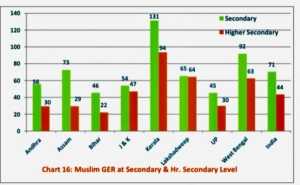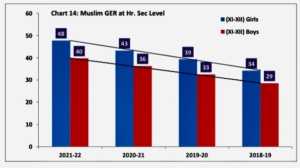Muslim Gross Enrolment Ratio at School Education in India (2021-22)
a) Muslim Child Population
In the absence of the 2021 Census and the lack of age-specific Muslim enrolment data, the estimation of the Muslim child population and subsequent calculation of the Gross Enrolment Ratio (GER) at different levels of school education becomes challenging. The article attempts to address this gap by using the total clientele population in specific age groups (6 to 11, 11 to 13, 14 to 15, and 16 to 17 years) as provided in the UDISE+ Booklet: Flash Statistics for the period from 2018-19 to 2021-22. The assumption is that the share of Muslims in the total population of India, as reported in the 2011 Census (14.23 percent), remains constant.
With this approach, the estimated Muslim child population is derived at the all-India level from 2018-19 to 2021-22 and the state level for 2021-22. The state-specific share of Muslims in the total population of 2011 is applied to the projected total child population in different age groups to estimate the Muslim child population at the state level.
Based on these estimations, the article computes the Gross Enrolment Ratio (GER) of Muslim children at all levels of school education. The article emphasizes that this attempt to calculate the Muslim GER is the first of its kind recently. It highlights the need for official and accurate data on the Muslim population and their enrolment. The Ministry of Education must approach the Ministry of Health & Family Welfare to include the Muslim population and refer it to the Expert Committee on Population Projections for future planning. Additionally, the Ministry of Education should consider including the collection of Muslim enrolment by age as part of its annual data collection to facilitate the computation of Net and age-specific enrolment ratios.
The article discusses the Muslim GER at different levels of school education at the all-India level from 2018-19 to 2021-22 and the state level for the latest year, 2021-22. This data will provide valuable insights into the enrolment patterns of Muslim children and aid in formulating targeted policies and interventions to ensure equitable access to education for all communities, including the Muslim community.
b) Muslim Enrolment Ratio (Overall)
The Gross Enrolment Ratio (GER) data presented in Tables 16 to 19 at the all-India level provides valuable insights into the participation of Muslim children in school education. The analysis reveals the following key findings:
- Better Participation at Elementary Levels: At the primary, upper primary, and combined elementary levels of education, the participation of Muslim children is better than that of all children at the all-India level. This trend holds for both boys and girls. It is heartening to observe that Muslim girls’ participation at all levels of school education in terms of GER in 2021-22 is also much better than their counterparts, boys.
- Lower Participation at Secondary and Higher Secondary Levels: The participation of Muslim children at the secondary and higher secondary levels of education is much lower than at the all-India level, indicating that many of them do not continue and transit to the secondary level of education. The GER at these levels is lower, which suggests the need for targeted interventions to improve access and retention.
- Significant Gender Gap: While overall participation of Muslim children in school education (Grades I-XII) is about 90 percent, girls are better placed than boys, and the difference in participation between the two is significant. The GER for Muslim girls is higher than that for Muslim boys at all levels of education.
- Need for Focused Efforts: Despite the overall improvement in the participation of Muslim children from 2018-19 to 2021-22, there is still a need to bring the remaining children under the education umbrella, retain them, and ensure smooth transitions from one level to another; this is essential to achieve the goal of universal school education.
In conclusion, the GER data highlights both positive and concerning trends in the participation of Muslim children in school education in India. While their participation at the elementary level is better than the national average, there are significant challenges in ensuring their participation and retention at the secondary and higher secondary levels. Addressing these challenges will require targeted efforts and interventions to promote equitable access to education for all children, regardless of their religious background or gender.
State-specific analysis on Muslim Enrolment at School Education in India (2021-22)
Table 16: Muslim GER, All India: 2018-19 to 2021-22
| Year | Primary (I-V) | Upper Primary (VI-VIII) | Elementary (I-VIII) | ||||||
| Girls | Boys | Total | Girls | Boys | Total | Girls | Boys | Total | |
| 2021-22 | 117.06 | 110.41 | 113.55 | 99.88 | 92.22 | 95.91 | 110.54 | 103.68 | 106.95 |
| 2020-21 | 116.90 | 110.50 | 113.53 | 97.09 | 88.00 | 92.37 | 109.36 | 102.09 | 105.56 |
| 2019-20 | 114.12 | 108.38 | 111.11 | 92.47 | 82.73 | 87.41 | 105.86 | 98.71 | 102.12 |
Note: Projected population of Muslims in different age groups has been obtained based on Expert Committee Projections (Total) by assuming that the 2011 Census share of 14.23 percent of Muslims to the Total population is still valid in 2021.
Table 17: Muslim Gross Enrolment Ratio at Secondary & Higher Secondary Levels
All India: 2018-19 to 2021-22
|
Year |
Secondary (IX-X) | Higher Secondary
(XI-XII) |
Total (I-XII) | ||||||
| Girls | Boys | Total | Girls | Boys | Total | Girls | Boys | Total | |
| 2021-22 | 74.78 | 66.56 | 70.51 | 47.71 | 39.71 | 43.54 | 93.54 | 86.38 | 89.80 |
| 2020-21 | 76.18 | 65.63 | 70.69 | 43.18 | 36.25 | 39.56 | 92.22 | 84.52 | 88.20 |
| 2019-20 | 72.73 | 62.09 | 67.18 | 39.30 | 32.50 | 35.75 | 88.68 | 80.99 | 84.66 |
| 2018-19 | 67.25 | 57.41 | 62.11 | 34.17 | 28.52 | 31.21 | 81.94 | 74.91 | 78.27 |
| Note: Projected population of Muslims in different age groups has been obtained based on Expert Committee Projections (Total) by assuming that the 2011 Census share of 14.23 percent of the Muslim to Total population is still valid in 2021. | |||||||||
Muslim Gross Enrolment Ratio at Secondary & Higher Secondary Levels (2021-22)
The data shows an improvement in the overall GER for Muslim students at both levels over the four-year period from 2018-19 to 2021-22. However, there is a notable gender gap in enrolment, with the GER for girls being lower than that for boys at both secondary and higher secondary levels.
Key findings are as follows:
Overall Improvement in GER: The overall GER for Muslim students at the secondary level has increased from 78.27 percent in 2018-19 to 89.80 percent in 2021-22. This indicates a positive trend in enrolment and participation of Muslim students at this level. A similar improvement is seen at the higher secondary level, where the GER has increased from 55.36 percent in 2018-19 to 71.33 percent in 2021-22.
Gender Gap in GER: Despite the overall improvement, there is a significant gender gap in enrolment at both levels. In 2021-22, the GER for girls at the secondary level is 74.78 percent, while for boys, it is 66.56 percent. At the higher secondary level, the GER for girls is 47.71 percent, while for boys, it is 39.71 percent. This suggests that more efforts are needed to address barriers and challenges that prevent Muslim girls from accessing and continuing their education at these levels.
Assumption of Population Figures: The data is based on projected population figures, assuming that the share of the Muslim population to the total population of India from the 2011 Census is still valid in 2021. However, it is essential to consider that population dynamics can change over time, and more accurate population estimates would provide a more precise representation of the enrolment situation.
Need for Targeted Efforts: To further improve enrolment and reduce the gender gap in GER, targeted efforts are required. These efforts may include addressing socio-economic factors, cultural barriers, providing safe and conducive learning environments, and promoting girls’ education.
Overall, while the data shows positive progress in the GER of Muslim students at the secondary and higher secondary levels, it also highlights the need for continued efforts to ensure equal opportunities for boys and girls in accessing and completing education at these levels. Accurate population estimates and targeted interventions will play a crucial role in achieving higher enrolment rates and promoting inclusive education for all.






